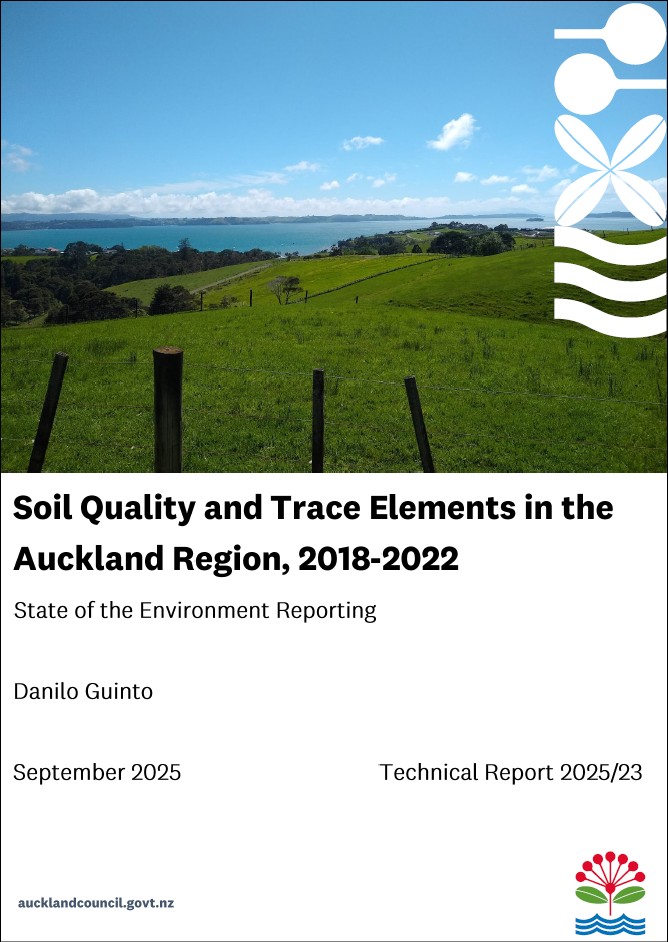Soil quality and trace elements in the Auckland region 2018-2022. State of the environment reporting
Author:
Danilo GuintoSource:
Auckland Council Environmental Evaluation and Monitoring Unit, EEMU | Engineering, Assets and Technical Advisory DepartmentPublication date:
2025Topics:
EnvironmentSoil quality and trace elements in the Auckland region, 2018-2022. State of the environment reporting
Executive summary
The soil is a non-renewable natural resource that provides several functions through maintaining environmental quality and supporting plant, animal and human health. The importance of the soil in supporting primary production is highlighted in the economic contribution of the Pukekohe horticulture industry estimated to be around $261 million per annum. Thus, soils need to be managed carefully to ensure sustainable production and minimise environmental degradation. Changes in the capacity of soil to function are reflected in soil properties that change in response to management or climate. These soil quality indicators are important in focusing conservation efforts or maintaining and improving the condition of the soil and in evaluating soil management practices.
As part of its State of the Environment (SoE) reporting, Auckland Council has been continuously monitoring topsoil quality (0-10 cm) since 1995. Periodic sampling is done under various land uses that include horticulture (outdoor vegetable and orchard sites), pasture (dairy, drystock and lifestyle block converted sites), urban (mainly parks), plantation forestry and native vegetation sites. Seven soil quality indicators are measured: pH, total carbon (C), total nitrogen (N), anaerobically mineralisable nitrogen (AMN), Olsen phosphorus (P), bulk density (BD) and macroporosity (MP). In addition, seven trace elements, namely total recoverable arsenic (As), cadmium (Cd), chromium (Cr), copper (Cu), nickel (Ni), lead (Pb) and zinc (Zn) are included.
The present report covers the current monitoring data from 2018-2022 and compares it with the 2013-2017 base period.
Many horticulture sites (65 per cent) have elevated Olsen P levels due to excessive P fertilisation. This presents a high risk of runoff into waterways and may lead to the eutrophication of surface water bodies. About 71 per cent are also compacted as reflected in their low macroporosity. In terms of bulk density, however, only 24 per cent are considered compacted which shows that bulk density is a less sensitive indicator of soil compaction. Soils under horticulture also have high proportions of total C (41 per cent) and AMN (47 per cent), respectively below their guideline values indicating low potential for mineralisation of nutrients like, N, P and sulphur (S).
Pasture soils are less enriched in Olsen P compared to horticulture soils, with only 37 per cent having elevated concentrations. However, like the horticulture soils, 70 per cent of samples are compacted. All sites passed the total C and AMN guideline values, although 30 per cent are outside the total N guideline range.
At urban sites, 50 per cent of samples failed the guideline range for Olsen P suggesting about half of the urban parks are receiving high P application. Under forestry land use, 73 per cent of soil samples have failed the guideline range for Olsen P. However, this is not an environmental concern because the samples that failed were below the lower limit of the guideline value which means that inadequate P fertiliser is being applied under plantation forestry to potentially benefit tree growth.
For all trace elements, the percentages of samples that are outside guideline ranges are 26 per cent or less with fails for Cu, Zn and Cd being most noticeable under pasture and horticulture land uses. For As and Ni, about 6 per cent or less of the sites were outside their respective guideline ranges under all land uses. In urban parks, about 17 per cent each of Cr and Pb fell outside their respective guideline range.
Mean concentrations of trace elements were generally within their guideline values and varied by land use, except for As. Horticulture and pasture soils had significantly higher Cd levels, attributed to long-term phosphate fertiliser application since Cd is an unavoidable impurity in phosphate fertilisers. Horticulture and urban sites had the highest mean concentrations of Cu, likely due to its use as a fungicide in horticulture. Urban soils had significantly higher mean Pb concentrations than other land uses, possibly due to historic vehicle emissions.
Comparisons between the 2018-2022 current period and the 2013-2017 base period across all land uses indicated only slight changes in soil quality indicators and trace elements and their differences were not statistically significant. This indicates the same issues of extreme P fertility, compaction and low organic resources in the more intensive land uses like outdoor vegetable production remain at the present.
While it is challenging to improve soil quality in intensive farming due to practices that exposes soil organic carbon to be lost to the atmosphere via microbial respiration, there is scope to adopt sustainable practices such as cover cropping, crop rotation, reduced tillage, composting, and promoting biodiversity. Within Auckland, several programmes and initiatives are now in place to address soil quality issues as well as water quality issues. These include the "Empowering Farmer Compliance for Auckland" guide packaged by Perrin Ag and funded by Auckland Council, and projects under the Te Tautara o Pukekohe Trust, such as freshwater and soil health monitoring, crop stacking, and sediment management. It is hoped that all current and future efforts to stem increasing soil quality degradation will ensure that highly productive soils support our primary land uses and enhance environmental sustainability.
Because of the importance of organic matter and the role that soil organisms play in crop production and environmental protection, future soil monitoring needs to consider the use of biological soil indicators, include the assessment of subsoil conditions, and conduct measurements of emerging contaminants like pesticide residues and microplastics.
Auckland Council technical report, TR2025/23
September 2025
See also
